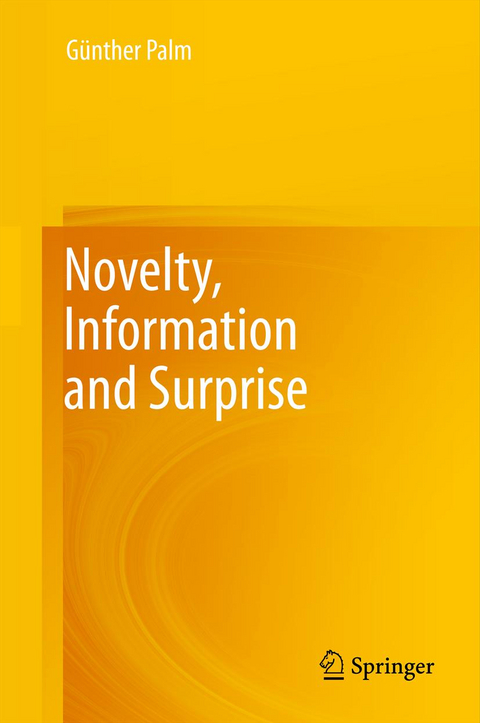
Novelty, Information and Surprise
Springer Berlin (Verlag)
978-3-642-43583-6 (ISBN)
- Titel ist leider vergriffen;
keine Neuauflage - Artikel merken
The book offers a new approach to information theory that is more general then the classical approach by Shannon. The classical definition of information is given for an alphabet of symbols or for a set of mutually exclusive propositions (a partition of the probability space ) with corresponding probabilities adding up to 1. The new definition is given for an arbitrary cover of , i.e. for a set of possibly overlapping propositions. The generalized information concept is called novelty and it is accompanied by two new concepts derived from it, designated as information and surprise, which describe "opposite" versions of novelty, information being related more to classical information theory and surprise being related more to the classical concept of statistical significance. In the discussion of these three concepts and their interrelations several properties or classes of covers are defined, which turn out to be lattices. The book also presents applications of these new concepts, mostly in statistics and in neuroscience.
Günther Palm studied mathematics in Hamburg and Tübingen. After completing his studies in mathematics (Master in 1974, Ph.D. in 1975) he worked on nonlinear systems, associative memory and brain theory at the MPI for Biological Cybernetics in Tübingen. In 1983/84 he was a Fellow at the Wissenschaftskolleg in Berlin. From 1988 to 1991 he was professor for theoretical brain research at the University of Düsseldorf. Since then he has served as a professor for computer science and Director of the Institute of Neural Information Processing at the University of Ulm, where his focus is on information theory, pattern recognition, neural networks, and brain modelling.
Part I Surprise and Information of Descriptions: Prerequisites.- Improbability and Novelty of Descriptions.- Conditional Novelty and Information.- Part II Coding and Information Transmission: On Guessing and Coding.- Information Transmission.- Part III Information Rate and Channel Capacity: Stationary Processes and Information Rate.- Channel Capacity.- Shannon's Theorem.- Part IV Repertoires and Covers: Repertoires and Descriptions.- Novelty, Information and Surprise of Repertoires.- Conditioning, Mutual Information and Information Gain.- Part V Information, Novelty and Surprise in Science: Information, Novelty and Surprise in Brain Theory.- Surprise from Repetitions and Combination of Surprises.- Entropy in Physics.- Part VI Generalized Information Theory: Order- and Lattice-Structures.- Three Orderings on Repertoires.- Information Theory on Lattices of Covers.- Appendices: A. Fuzzy Repertoires and Descriptions.- A.1 Basic Definitions.- A.2 Definition and Properties of Fuzzy Repertoires.- Glossary.- Bibliography.- Index.
From the reviews:
"In this interesting book, the author extends classical Shannon information theory to include the subjective element of interestingness, novelty or surprise. ... A theory of novelty and surprise is developed in this book to provide a brief and comprehensive exposition of classical information theory ... . all the chapters have exercises, and so this book can be used as an undergraduate/graduate textbook. Since each chapter contains a decent number of references ... readers can find research problems from those references." (Yûichirô Kakihara, Mathematical Reviews, July, 2013)
"In this book the author introduces (subjective) notions of interestingness, novelty and surprise of messages employing probality spaces ... . The book is easy to read and does not require strong mathematical background, thus it could be used as a textbook or as material for self-study in graduate or post-graduate courses." (Jaak Henno, Zentralblatt MATH, Vol. 1257, 2013)| Erscheint lt. Verlag | 20.9.2014 |
|---|---|
| Zusatzinfo | XXIV, 248 p. |
| Verlagsort | Berlin |
| Sprache | englisch |
| Maße | 155 x 235 mm |
| Gewicht | 421 g |
| Themenwelt | Mathematik / Informatik ► Informatik ► Theorie / Studium |
| Mathematik / Informatik ► Mathematik ► Angewandte Mathematik | |
| Schlagworte | Cover • Information • Information and Communication, Circuits • lattice • Novelty • Surprise |
| ISBN-10 | 3-642-43583-1 / 3642435831 |
| ISBN-13 | 978-3-642-43583-6 / 9783642435836 |
| Zustand | Neuware |
| Informationen gemäß Produktsicherheitsverordnung (GPSR) | |
| Haben Sie eine Frage zum Produkt? |
aus dem Bereich


